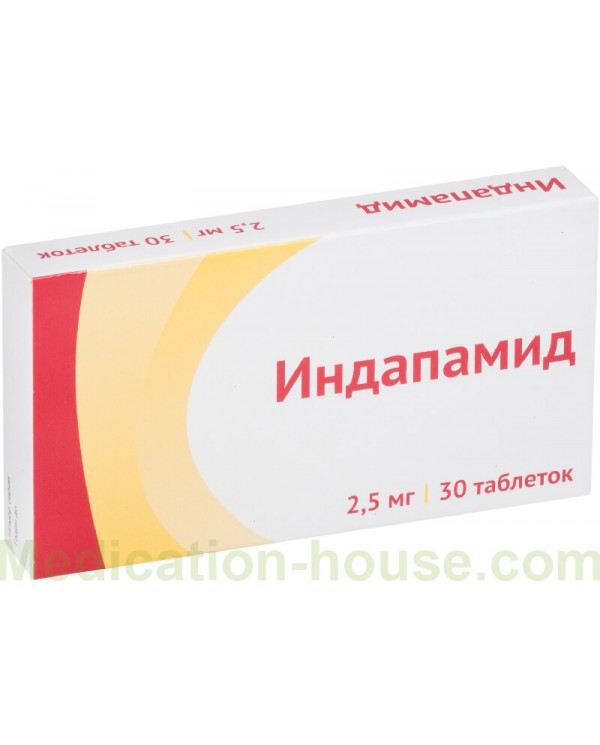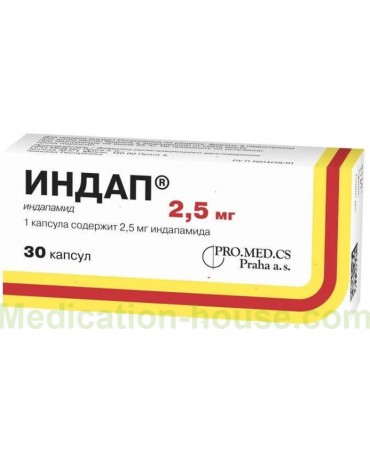User manual for Indapamide
To buy Indapamide just add it to your shopping cart
Indapamide is a drug with vasodilating, hypotensive and diuretic effects.
Release form and composition
Indapamide is available in the following dosage forms:
Film-coated tablets (20, 30 pcs. In polyethylene bottles or cans, 1 bottle or can in a cardboard box; 10, 20, 30 pcs. In blisters, 1-6, 8, 10, 20, 40, 60, 80, 100 packages in a cardboard box; 10 pcs. In polymer containers, 1, 10, 20, 30, 40, 50, 100 containers in a cardboard box; 20, 30, 40, 50 pcs. In polymer containers, 1, 10, 20 containers in a cardboard box).
The preparation contains an active substance - indapamide:
Capsules, film-coated tablets and film-coated tablets - 2.5 mg.
Auxiliary components:
Film-coated tablets: polyethylene glycol, lactose monohydrate (Type 312), lactose monohydrate (Spray-Dried), microcrystalline cellulose, magnesium stearate, croscarmellose sodium.
Pharmacodynamics
Indapamide is a sulfonamide derivative, and its pharmacological properties are similar to those of thiazide diuretics. It is characterized by moderate saluretic and diuretic effects associated with a slowdown in the reabsorption of chlorine, sodium and, to a lesser extent, magnesium and potassium ions in the cortical segment of the distal nephron tubule and in the proximal renal tubules.
Indapamide reduces the tone of the smooth muscles of the arteries and has a vasodilating effect, and also provides a decrease in the total peripheral vascular resistance. These effects are due to a decrease in the reactivity of vascular walls to angiotensin II and norepinephrine, inhibition of calcium flow in vascular smooth muscle cells, and activation of the production of prostaglandin E2 in the body, which is characterized by a vasodilating effect.
With the use of indapamide, a decrease in left ventricular hypertrophy of the heart is observed. The substance exhibits antihypertensive properties when taken in doses that do not have a pronounced diuretic effect.
For thiazide and thiazide-like diuretics, after exceeding a certain therapeutic dose, the formation of a plateau of the therapeutic effect is characteristic, while the severity of unwanted side reactions continues to increase. Therefore, it is not recommended to increase the dose of indapamide if the therapeutic effect is not achieved when taking the drug in the recommended dose.
With the systematic administration of the drug, the therapeutic effect is observed 1–2 weeks after the start of treatment, reaches a peak by 8–12 weeks and lasts up to about 8 weeks. After a single dose of indapamide, the maximum effect is recorded after 24 hours.
Pharmacokinetics
After oral administration, indapamide is rapidly and almost 100% absorbed from the gastrointestinal tract. Food intake slightly reduces the rate of absorption, but does not affect its completeness in any way. After a single dose of the drug, the maximum concentration of the active component in the blood plasma is determined after 0.5–2 hours.
The degree of binding of indapamide to blood plasma proteins is approximately 76-79%. Since the substance has a high affinity for elastin, it is mainly accumulated in the smooth muscles of the vascular walls. Indapamide also reacts with erythrocyte carbonic anhydrase without suppressing the activity of this enzyme. The drug is metabolized in the liver, and its equilibrium concentration is determined after 7 days of regular intake. Repeated use of indapamide does not lead to its cumulation in the body. The substance has a large volume of distribution, overcomes histohematological barriers, including placental, and is determined in breast milk.
Indapamide is excreted to a large extent in urine (60–70% of the dose taken) and in feces (16–20%) in the form of pharmacologically inactive metabolites. About 7% of the active substance is excreted unchanged. The half-life is 14-18 hours. In patients with renal insufficiency, the pharmacokinetic parameters of indapamide remain unchanged.
Indications for use
According to the instructions, Indapamide is prescribed for the treatment of arterial hypertension.
Contraindications
Severe renal failure (at the stage of anuria);
Severe liver failure (including with encephalopathy);
Galactosemia;
Hypokalemia;
Glucose / galactose malabsorption syndrome, lactose intolerance;
Simultaneous administration with drugs that lengthen the QT interval;
Pregnancy and lactation;
Age up to 18 years (the safety and efficacy of the drug for this age group of patients have not been established);
Hypersensitivity to the components of the drug, as well as to other sulfonamide derivatives.
Indapamide should be taken with caution in patients with functional disorders of the kidneys and / or liver, diabetes mellitus in the stage of decompensation, hyperuricemia (especially accompanied by urate nephrolithiasis and gout), imbalance in water and electrolyte balance, hyperparathyroidism, with an increased QT interval on the ECG or receiving other antiarrhythmic drugs.
Instructions for use: method and dosage
Indapamide is taken orally, once, in the morning, without chewing and drinking a sufficient amount of liquid.
The daily dose of the drug is 1 tablet (in the form of extended-release tablets and modified-release coated tablets - 1.5 mg; capsules, film-coated tablets and film-coated tablets - 2.5 mg). If after 1-2 months of therapy the desired therapeutic effect is not achieved, it is not recommended to increase the dose of Indapamide (due to the increased risk of side effects without increasing the antihypertensive effect). In these cases, another non-diuretic antihypertensive drug should be included in the drug regimen. When taking two different drugs, the dose of Indapamide should not be adjusted (1 tablet per day, once, in the morning).
Side effects
While taking Indapamide, disorders may develop on the part of some body systems:
Cardiovascular system: orthostatic hypotension, arrhythmia, ECG changes (hypokalemia), palpitations;
Central nervous system: nervousness, asthenia, headache, drowsiness, dizziness, insomnia, vertigo, depression; rarely - malaise, general weakness, increased fatigue, muscle spasm, irritability, tension, anxiety;
Digestive system: abdominal pain, nausea, dry mouth, anorexia, vomiting, gastralgia, diarrhea, constipation, hepatic encephalopathy may develop; rarely - pancreatitis;
Urinary system: nocturia, frequent infections, polyuria;
Respiratory system: sinusitis, pharyngitis, cough; rarely - rhinitis;
Hematopoietic system: very rarely - leukopenia, thrombocytopenia, agranulocytosis, hemolytic anemia and bone marrow aplasia;
Laboratory indicators: hypercalcemia, hyperuricemia, hypokalemia, hyperglycemia, hyponatremia, hypochloremia, increased plasma urea nitrogen, glucosuria, hypercreatininemia;
Allergic reactions: hemorrhagic vasculitis, urticaria, rash, itching;
Others: exacerbation of the course of systemic lupus erythematosus.
Overdose
An overdose of Indapamide can be determined by symptoms such as polyuria or oliguria up to anuria (due to hypovolemia), a marked decrease in blood pressure, depression of the respiratory center, water-electrolyte disturbances (hypokalemia, hyponatremia), lethargy, drowsiness, confusion, dizziness, seizures , nausea, vomiting. Patients diagnosed with cirrhosis of the liver may develop hepatic coma.
As a treatment, symptomatic therapy is recommended (gastric lavage and / or intake of activated carbon, measures to restore water and electrolyte balance). The specific antidote is unknown.
Special instructions
Elderly patients and patients taking laxatives and cardiac glycosides against the background of hyperaldosteronism need to regularly monitor the content of potassium and creatinine ions.
During therapy, it is necessary to systematically monitor the concentration of sodium, magnesium and potassium ions in the blood plasma (due to possible electrolyte disturbances), pH, the concentration of glucose, residual nitrogen and uric acid. The first study of the concentration of potassium in the blood is carried out during the first 7 days of treatment.
Also, the high-risk group includes patients with an increased QT interval on the ECG (developed against the background of any pathological process or congenital).
The most careful monitoring is needed in patients with cirrhosis of the liver (especially with ascites or edema, which is associated with the risk of metabolic alkalosis, which increases the severity of hepatic encephalopathy), heart failure, coronary heart disease, as well as elderly patients.
Hypercalcemia that develops during the use of Indapamide may indicate the presence of previously undiagnosed hyperparathyroidism.
It is necessary to control the level of glucose in the blood in patients with diabetes mellitus, especially with hypokalemia.
Significant dehydration can lead to acute renal failure (decreased glomerular filtration rate). Patients should compensate for water loss and carefully monitor renal function at the beginning of therapy.
During doping control, Indapamide can give a positive result.
In case of arterial hypertension and hyponatremia (associated with taking diuretics), it is necessary to interrupt the intake of diuretics 3 days before the start of taking angiotensin-converting enzyme inhibitors (if necessary, diuretics can be resumed a little later), or prescribe initial angiotensin-converting enzyme inhibitors in low doses.
Derivatives of sulfonamides can exacerbate the course of systemic lupus erythematosus (must be taken into account when prescribing Indapamide).
In some cases, individual reactions are possible during therapy, which are associated with changes in blood pressure, especially at the beginning of therapy and when another antihypertensive drug is added. This can reduce the ability to drive and perform tasks requiring increased attention.
Application during pregnancy and lactation
The use of Indapamide in pregnant women is not recommended. Its reception can provoke the development of placental ischemia, which can slow down the development of the fetus.
Since indapamide passes into breast milk, it should not be administered during lactation. If it is necessary to take the drug by lactating patients, breastfeeding should be discontinued.
Drug interactions
With the simultaneous use of Indapamide with some drugs, undesirable effects may occur:
Saluretics, laxatives, cardiac glycosides, tetracosactide, gluco- and mineralocorticoids, amphotericin B (intravenous): increased risk of hypokalemia;
Cardiac glycosides: an increase in the likelihood of developing digitalis intoxication;
Erythromycin (intravenous), astemizole, pentamidine, vincamine, terfenadine, sultopride, class I A antiarrhythmics (disopyramide, quinidine) and class III (bretilium tosylate, amiodarone, sotalol): development of arrhythmias of the "pirouette" type (torsades de pointes);
Non-steroidal anti-inflammatory drugs, tetracosactide, glucocorticosteroids, sympathomimetics: reducing the hypotensive effect;
Calcium supplements: an increase in the likelihood of developing hypercalcemia;
Antipsychotics and imipramine (tricyclic) antidepressants: increased hypotensive effect and increased risk of orthostatic hypotension;
Cyclosporine: increased risk of developing hypercreatininemia;
Metformin: increased likelihood of worsening lactic acidosis;
Angiotensin-converting enzyme inhibitors: increased risk of acute renal failure and / or arterial hypotension (especially with existing renal artery stenosis);
Iodine-containing contrast media in high doses: an increase in the risk of developing impaired renal function (dehydration of the body is possible, before using iodine-containing substances, patients need to restore fluid loss);
Baclofen: increased hypotensive effect;
Potassium-sparing diuretics: development of hyper- or hypokalemia, especially in patients with renal failure and diabetes mellitus (in some category of patients, this combination may be effective);
Indirect anticoagulants (derivatives of indandione or coumarin): a decrease in their effect (dose adjustment may be required);
Non-depolarizing muscle relaxants: strengthening the blockade of neuromuscular transmission that develops under their influence.
Indapamide increases the concentration of lithium ions in the blood plasma (decrease in excretion in the urine), lithium has a nephrotoxic effect.
Terms and conditions of storage
Store in a dry, dark place, out of reach of children.
Shelf life - 3 years at a temperature of 15-30 ° C;
Reviews about Indapamide
According to reviews, Indapamide is a highly effective drug. Both doctors and patients with hypertension note that this drug is generally well tolerated. Adverse reactions are very rare and mild. Many patients diagnosed with hypertension take pills throughout their lives.
Terms of sell
You can buy Indapamide without a prescription.


